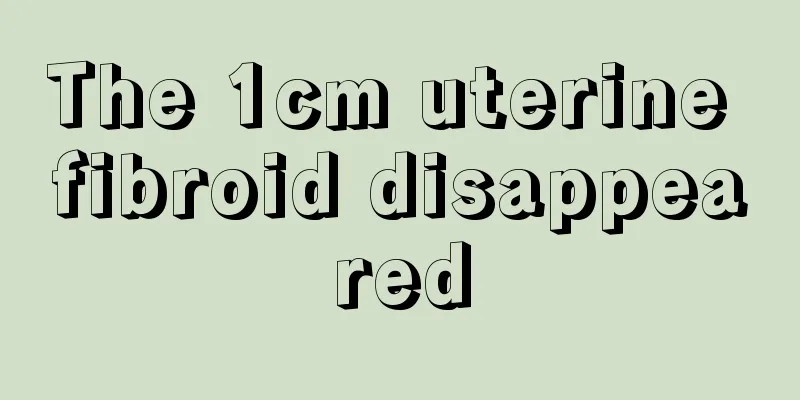The 1cm uterine fibroid disappeared

|
In obstetrics and gynecology, uterine fibroids are also a common disease. The doctor will use the examination results to determine the size of your tumor and then provide further treatment. Treatment is divided into surgical treatment and conservative treatment, which is determined according to the condition. Therefore, you should cooperate closely with your doctor. So how did the 1cm uterine fibroid disappear? Next, the editor will share with you the opinions of the experts. How did a 1cm uterine fibroid disappear? When treating uterine fibroids, the doctor will determine the specific treatment plan based on the size of the patient's uterine fibroids to ensure targeted treatment. For patients with uterine fibroids smaller than 5 cm, the doctor will use hopeful treatment, which is a method of regular follow-up observation. This method is used to detect the size of the patient's uterine fibroids. If the patient's uterine fibroids suddenly increase in size or abnormal bleeding is found in the vagina, other treatments should be performed. Therefore, patients with uterine fibroids only 1 cm in size may not need to receive special treatments, and some patients' uterine fibroids will disappear on their own after a period of time, especially those women around menopause. What are the symptoms of uterine fibroids? 1. Irregular menstruation Irregular menstruation with increased menstrual volume and prolonged menstrual duration is the most common symptom of uterine fibroids. 2. Lower abdominal mass Uterine fibroids are not felt as lumps in the abdomen at first, but can be felt from the abdomen when the uterine fibroids gradually expand and the uterus exceeds 3 months of pregnancy. 3. Excessive leucorrhea Intramural fibroids expand the total area of the uterine cavity, increase the metabolism of the endometrial glandular ducts, and are accompanied by pelvic congestion leading to excessive leucorrhea; once submucosal uterine fibroids are infected, there may be a lot of thick secretions. If there is a rupture. Although uterine fibroids sound scary and seem like tumors. But in fact, most of these symptoms are benign and do not cause much harm to women's bodies. But if it is not treated for a long time, it may be serious. Therefore, women's gynecological diseases must be paid attention to. If economic conditions permit, go to the hospital for a comprehensive gynecological examination every year. This is very important for women. |
<<: Can endometriosis be cured?
>>: Bleeding after hysterectomy
Recommend
Symptoms of residual material after abortion
Some people do not take proper contraceptive meas...
What should I do if I don't have my period after taking Progynaecology?
Important reminder: This article mainly introduce...
Why do girls sleep so much?
Falling asleep is a very happy thing, especially ...
Three months of medical abortion
Many women with unexpected pregnancies want to ha...
What is the best way to delay uterine aging?
As we all know, a woman's uterus is the main ...
Symptoms of morning sickness and electrolyte imbalance
Women will experience many physical changes after...
What is the reason for not having menstruation for 4 months?
As we all know, menstruation should come once a m...
Is it a boy or a girl if the belly is round during pregnancy
Generally speaking, pregnant women's abdomen ...
How do girls get body odor?
Through investigation, it was found that the inci...
Where is red okra mainly distributed? When is the best season to eat red okra?
Green okra, also known as yellow okra, is the mos...
Can I get pregnant if my menstrual period is dark and light?
Many women experience light or heavy menstrual fl...
The health hazards of drinking tea during menstruation
What foods are good to eat during menstruation an...
What is the cause of yellow leucorrhea
Leucorrhea is a special physiological phenomenon ...
Can you massage after medical abortion?
Medical abortion is a relatively common way to ge...


![[Health Lecture] How should the diet of the elderly be adjusted?](/upload/images/67f1033c3e4d5.webp)






